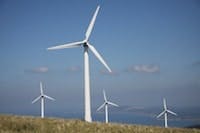A new study was released by the American Council On Renewable Energy (ACORE), California Clean Energy Fund (CalCEF), and Climate Policy Initiative at the Renewable Energy Finance Forum-Wall Street where hundreds of leaders from the renewable energy industry convened to discuss the current state of renewable energy finance.
The study titled "Strategies to Scale-Up U.S. Renewable Energy Investment" highlights the role of policy at the state, federal and regulatory level in unlocking record levels of private capital in the industry during the past decade. The paper also explores policies that would significantly increase private capital into renewable energy development.
"When we consider the entire portfolio of energy sources, it is clear that renewable energy has the strongest value proposition," said Vice Admiral Dennis McGinn during a press conference discussing the paper at the Renewable Energy Finance Forum-Wall Street. "Since 2004, the private sector has invested more than $300 billion in the U.S. renewable energy market, and as a result we've seen a great increase in job creation, project development and cost reduction. We need to continue to educate the public, promote stable policies and create additional financing mechanisms for renewable energy to accelerate America's journey to a more secure and prosperous clean energy future."
The paper goes into detail about ways state and federal policies can work together to create a strong policy framework for renewable energy financiers. Further, the paper finds that state policies such as Renewable Portfolio Standards (RPS) have effectively leveraged over a hundred billion dollars in private investment into the 29 states with RPS policies. These policies have been extremely effective at maximizing the amount of private investment in renewable energy projects, and as a result, all 50 states should aim to strengthen or create a policy framework aimed at leveraging private capital into this industry.
"Just look at the past two years and you'll see that we've had the best two years on record for private investment in the industry," said Dan Adler, managing director of CalCEF. "And what's incredible about this industry is that its true potential has not yet been met. More private capital wants into this industry and there are many ways, both proven and innovative, that can accomplish this. It's vital that policymakers of all types including public utility commissions across the country take the steps available to foster more private capital to power this industry. These policies have worked, but policymakers can do more to unlock the true potential of the private market to support this industry."
The study also explores how federal policies play an important role in leveraging private dollars into renewables, which has in turn lead to technological advances that have resulted in steep cost reductions of clean energy technologies. These advances led to a capstone year in 2012 when 49% of new electrical generation capacity brought online was from renewables, beating natural gas. Still, garnering more low-cost capital remains a priority for the industry and a problem that that can be resolved with tweaks in the tax code and strengthened policy aimed at increasing private sector cash flow into the industry.
"The next step is to drive low-cost private investment—and to do so as cost-effectively as possible," added Uday Varadarajan, a senior analyst at Climate Policy Initiative. "There are many ways to do this that build on the success of current policy efforts—such as improving current tax incentives, opening up Master Limited Partnerships (MLPs) to renewables, and fixing policy barriers to institutional investor investment in renewable energy."
The release of the finance paper comes at important time when the debate surrounding key issues such as the Production Tax Credit (PTC), MLPs and other policies have come to the forefront of the energy and tax reform discussion on Capitol Hill.
"We're at an important juncture," said Todd Foley, senior vice president of policy and government relations at ACORE. "Energy tax policy is at the crux of important discussions occurring in D.C. right now and these issues will shape America's energy future. Existing tax policies continue to be successful in driving private capital investment. And renewable energy access to MLPs and Real Estate Investment Trust policies would make available even larger sources of private capital needed for scale-up. We must get this right."
Source: ACORE


